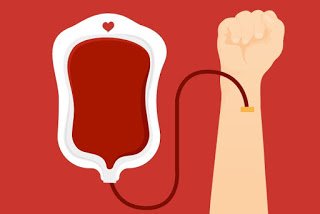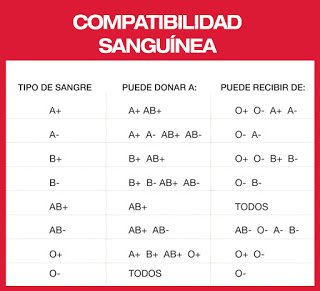
Blood transfusion:
Blood transfusion is a medical procedure that involves passing blood or some of its derivatives from a donor to a recipient to replenish blood volume, improve hemoglobin and the ability to transport oxygen and other substances, correct protein levels or to compensate for a deficit in the fields and components of the blood.
Concepts to consider:
Blood is like the organism's transport system. When blood circulates, it distributes oxygen and nutrients for the whole body. It also collects waste products and transports them to the bodies responsible for eliminating them abroad.
Blood is a mixture of cells and fluid, and each of its components has a specific function.
Red blood cells:
They transport oxygen to the tissues of the body and eliminate carbon dioxide.
White Globules:
They defend the body from infections by making antibodies that help destroy foreign germs that enter the body.
Platelets:
They are smaller cells that help the blood to coagulate and control bleeding.
Plasma:
It is the yellow liquid part of the blood. It is a mixture of water, proteins, electrolytes, carbohydrates, cholesterol, hormones and vitamins.

Objectives of blood transfusion:
· Replacement of blood volume.
· Provide plasma factors.
· Improve blood capacity to transport oxygen by increasing circulating hemoglobin.
Process:
Verify the indication of the medium of the transfusion in the file and fill the application to the blood bank, specifying the amount, type of blood product, factor RH, hemoglobin, hematocrit, reactions to previous transfusions, date of last transfusion, ect.
Send the request to the blood bank accompanied by a blood sample in a red tube for typing and compatibility, labeling the tubes very well.
Request the authorization of the patient or relatives.
Obtain blood and / or components from the blood bank.
Verify registration and label of safe blood, patient data, bed number, type of blood component, blood group and RH factor of the patient and the donor, unit number, expiration date and any alteration that the package could present . Nurse help is requested to corroborate the aforementioned information.
Wash your hands.
Put on gloves.
Prepare administration team.
Equipment:
· Blood management equipment with filter or without filter in case of platelets.
· Venous puncture equipment (catheter, ligature, swabs with antiseptic solution, etc).
· Gloves, for if necessary, install venous access.
Tripie
Nursing care:
· Check blood type, type RH, unit number and dates.
· Observe the patient the signs and symptoms of transfusion reactions (itching, vertigo, shortness of breath and chest pain).
· Monitor the IV puncture site for signs of infiltration and local infection.
· Control S.V before, during and after the transfusion.
· Manage Sun.Salina when the transfusion has finished.
· Record the time of the transfusion.
· Register transferred volume.
· Stop the transfusion if blood reactions occur and keep the vein clear with Sol.Salina.
· Obtain a blood sample and the first sample of urine emitted after the transfusion reaction.
· In case of a blood reaction, notify the laboratory immediately.
Precautions:
To minimize the risk of an adverse reaction during transfusion, medical personnel take many precautions. Generally, a few days or hours before the transfusion begins, a technician mixes a drop of donor blood with the recipient's blood to ensure compatibility.
After a double check of the labels stuck in the blood bags to be administered, to make sure that the transfusion is correct, the blood is slowly supplied to the recipient, the transfusion of each unit of blood is usually 1 to 2 hours. Since most adverse reactions occur during the first 15 minutes of the transfusion, the recipient undergoes careful observation at the beginning of the procedure.
Most transfusions are safe and successful. However, there may be occasional mild reactions and, very rarely, serious and even deadly reactions.
The most common reactions, which occur in 1 to 2% of transfusions, are:
· Fever.
· Allergic reactions.
Serious Reactions:
· Overload of liquids.
· Pulmonary injury.
· Degradation of red blood cells (erythrocytes).
Blood groups and RH compatibility:
Group A: That group of blood whose red blood cells have the antigen A and in which their plasma we find the Anti-B antibody.
Group A-B: Your red blood cells have both types of antigen A and B but the plasma has no antibody.
Group B: Your red blood cells have the B antigen and your plasma the Anti-A antibodies.
Group O: In this blood group the red blood cells do not have antigens, but the plasma has Anti-A and Anti-B antibodies.
Blood compatibility:

Thanks for visiting my post reacts ;)
Thank you for your contribution. Dont forget to link references and sources when applicable!
=======================================================================================
This post was upvoted and resteemed by Steemgridcoin with the aim of promoting discussions surrounding Gridcoin and science.
This service is free. You can learn more on how to help here.
Have a nice day. :)
Congratulations @fran0525! You have completed the following achievement on Steemit and have been rewarded with new badge(s) :
Click on the badge to view your Board of Honor.
If you no longer want to receive notifications, reply to this comment with the word
STOP